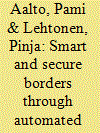| Srl | Item |
| 1 |
ID:
142781


|
|
|
|
|
| Summary/Abstract |
Since 2001, border security policy between Canada and the US has morphed from “smart borders” to the present “beyond the border” (perimeter security) agreement resulting in the expansion of new techniques of border surveillance including pre-emptive profiling of travellers and biometric data sharing. In this paper, we argue that these border agreements have increasingly resulted in a changing experience of sovereign power for those crossing the border. This is demonstrated through a discussion of: the major border policies between Canada and the US since 11 September 2001, developed under the influence of US hegemony; how these policies perpetrate a generalised state of exception; and how these policies affect refugees, migrants, and citizens. Reading Agamben’s insights from a sociological perspective, we argue that the presumption of security-through-surveillance erodes border crossers’ human rights, and that some people – those from disadvantaged race/class backgrounds – are more affected than others by the implementation of the evolving border regime. We also emphasise the contingencies and unintended consequences of the ongoing projects. The conclusion offers brief comments on the consequences of these developments on Canadian identity and points out the directions for future research in this domain.
|
|
|
|
|
|
|
|
|
|
|
|
|
|
|
|
| 2 |
ID:
153341


|
|
|
|
|
| Summary/Abstract |
The European Commission launched the “Smart Borders” policy process in 2011 to enhance border security in the European Union (EU) using technologisation and harmonisation. This includes the use of automated border control (ABC) systems. The Member States crucially shape the process, weighing security technologies and costs, privacy and rights, and further institutional choices. We examine the views of political stakeholders in four Member States by conducting a systematic empirical and comparative study unprecedented in the existing, political-theory-inspired research. In our Q methodological experiments, political stakeholders in Finland, Romania, Spain and the UK rank-ordered a sample of statements on Smart Borders, ABC and harmonisation. The factor analysis of the results yielded three main views: the first criticising ABC as a security technology, the second welcoming the security gains of automation and the third opposing harmonised border control. While impeding harmonisation, the results offer a consensus facilitating common policy.
|
|
|
|
|
|
|
|
|
|
|
|
|
|
|
|
| 3 |
ID:
147320


|
|
|
|
|
| Summary/Abstract |
This contribution asks how the reliance on mass dataveillance of travellers is sustained as a central policy option in the governance of EU border security. It examines this question by analysing a recent initiative of the European Commission proposing the establishment of EU ‘smart borders’. The analysis draws from a set of thinking tools developed by the sociology of association in the field of science and technology studies. The contribution argues that in order to grasp policy outcomes such as smart borders, security studies would benefit from adopting a compositional outlook on agency, where action is seen as the effect of associated entities. Looking at the smartening of EU borders, the article finds that this process is held together by multiple translations and enrolments through which the technical side of dataveillance – platforms, automated gates, matching systems, and so forth – has become associated with the processes of policymaking on border security and sustains the furtherance of mass dataveillance.
|
|
|
|
|
|
|
|
|
|
|
|
|
|
|
|